Welcome to our guide on Kenmore top-load washer error codes. This section introduces you to common error codes, their meanings, and troubleshooting solutions to help you diagnose and fix issues quickly.
Overview of Kenmore Washer Error Codes
Kenmore washer error codes are designed to help users and technicians quickly identify and diagnose issues with the appliance. These codes, such as E1, E2, and E3, represent specific problems like water supply issues, drain pump malfunctions, or sensor errors. By understanding these codes, you can pinpoint the root cause of the problem, whether it’s a blocked drain, faulty temperature sensor, or incorrect water pressure. Each code corresponds to a particular component or system, making troubleshooting more efficient. Regular maintenance, such as cleaning filters and checking connections, can prevent many of these errors. Familiarizing yourself with these codes ensures your Kenmore washer runs smoothly and prolongs its lifespan. This guide provides a comprehensive overview of common error codes and their solutions, helping you address issues promptly and effectively.
Importance of Understanding Error Codes
Understanding Kenmore washer error codes is crucial for maintaining your appliance’s performance and extending its lifespan. These codes act as a diagnostic tool, helping you identify issues early before they escalate into costly repairs. By recognizing error codes like E1 or E2, you can address problems such as water supply issues or drain pump malfunctions promptly. This knowledge empowers you to take corrective actions, such as cleaning the drain filter or checking water connections, without needing professional assistance. Regular maintenance, guided by error code insights, ensures your washer operates efficiently and effectively. In addition, understanding these codes reduces downtime, allowing you to resolve issues quickly and keep your laundry routine uninterrupted. This guide emphasizes the significance of being proactive with error codes to maintain optimal washer functionality and save money on repairs.

Common Error Codes and Their Meanings
This section explains the most common Kenmore top-load washer error codes, such as E1, E2, and E3, and provides insights into their causes and solutions for quick fixes.
E1 Error Code: Water Supply Issue
The E1 error code on your Kenmore top-load washer indicates a water supply problem. This occurs when the washer detects insufficient water flow or low water pressure. Common causes include closed water supply valves, kinked or blocked inlet hoses, or a malfunctioning water pressure sensor. To resolve this, ensure both hot and cold water valves are fully open and check for any kinks or blockages in the hoses. Additionally, verify that the water pressure sensor is functioning correctly. If issues persist, consult the Kenmore error code guide for further troubleshooting steps or consider professional assistance to diagnose sensor-related problems.
E2 Error Code: Drain Pump Problem
The E2 error code on your Kenmore top-load washer signifies a drain pump issue. This typically occurs when the drain pump is blocked, malfunctioning, or unable to expel water properly. Common causes include a clogged drain pump filter, debris in the pump, or a faulty drain pump motor. To resolve this, start by checking and cleaning the drain pump filter, located at the bottom of the washer. Remove any debris or obstructions and ensure the filter is securely replaced. If the issue persists, inspect the drain hose for kinks or blockages and verify that the washer is properly drained. In severe cases, the drain pump may need replacement, which is best handled by a professional technician to ensure optimal performance and prevent further damage.
E3 Error Code: Temperature Sensor Malfunction
The E3 error code on your Kenmore top-load washer indicates a temperature sensor malfunction. This sensor monitors water temperature during cycles, ensuring safe and efficient operation. A faulty sensor can prevent accurate temperature regulation, leading to issues like incomplete washing or overheating. Common causes include a defective sensor, loose connections, or wiring problems. To resolve this, first, check the sensor connections to ensure they are secure. If the issue persists, the temperature sensor may need replacement. Additionally, inspect the wiring for damage or corrosion. If you’re unsure, consult a professional technician to diagnose and repair the sensor or related components. Addressing this issue promptly prevents further damage to your washer and ensures optimal performance.

Troubleshooting Steps for Kenmore Washers
Troubleshooting your Kenmore washer involves checking error codes, resetting the appliance, and inspecting components like the drain pump and water supply connections for issues.

How to Reset Your Kenmore Washer
To reset your Kenmore washer, unplug it from the power source and wait for 5 minutes. Plug it back in and check if the error code persists. This simple step can often resolve issues like E2 F6 by resetting the control board. If the problem remains, further troubleshooting may be needed. Always ensure the washer is unplugged before attempting any repairs. This method is a quick fix for minor glitches but may not address underlying mechanical issues. By resetting, you allow the washer to clear temporary errors and restart its system. If the error recurs, refer to the specific code meaning for further guidance. Resetting is a crucial first step in diagnosing and resolving Kenmore washer issues effectively.
Checking and Cleaning the Drain Pump Filter
Regularly inspecting and cleaning the drain pump filter is essential for maintaining your Kenmore washer’s performance. A clogged filter can cause error codes like E2, indicating a drainage issue. To access the filter, locate it at the bottom of the washer or behind a panel, depending on the model. Remove any debris or lint accumulated in the filter and rinse it thoroughly with water. Reinstall the clean filter and ensure it’s securely in place. This simple maintenance task can prevent blockages and keep your washer running smoothly. If the error persists after cleaning, further inspection of the drain pump may be necessary. Cleaning the filter is a straightforward process that helps avoid costly repairs and ensures efficient operation of your Kenmore top-load washer.
Verifying Water Supply Connections
Verifying water supply connections is a crucial step in resolving issues related to error codes like E1, which indicate water supply problems. Start by checking the water supply hoses for kinks, blockages, or leaks. Ensure they are securely connected to both the washer and the water supply valves. Turn off the water supply valves and inspect the hoses for any signs of damage or wear. If necessary, replace the hoses to prevent future issues. Also, check the water supply valves to ensure they are fully open, allowing proper water flow. Inspect the inlet filters on the washer’s water inlet valves for mineral buildup or debris, as this can restrict water flow. Cleaning or replacing these filters can resolve low water pressure issues. Regularly verifying these connections helps maintain optimal performance and prevents error codes from appearing.
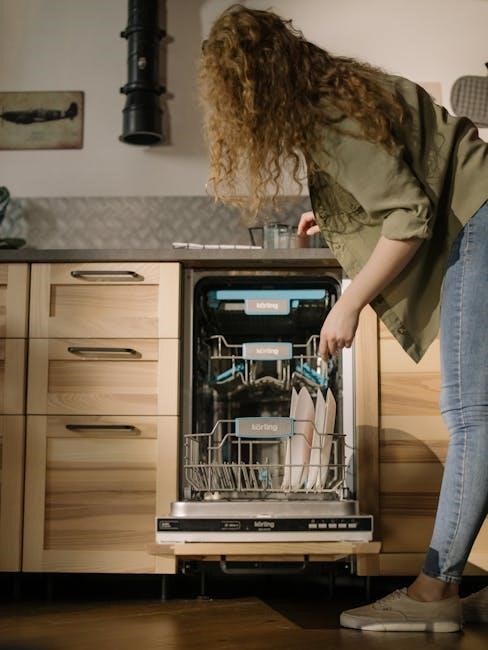
Model-Specific Error Codes
Kenmore top-load washers have model-specific error codes, such as the 796, 110, and 700 series, each with unique codes and solutions. Refer to your model’s guide for precise troubleshooting.
Kenmore 796 Series Error Codes
The Kenmore 796 series top-load washers use specific error codes to indicate issues. Common codes include E1 (water supply problems), E2 (drain pump issues), and E3 (temperature sensor malfunctions). These codes help identify problems like blocked pumps, faulty sensors, or improper water connections. For instance, an E1 error suggests checking water supply hoses for kinks or blockages, while E2 may require cleaning the drain pump filter. Referencing the official Kenmore error code guide or the 796.3155 series PDF manual can provide detailed troubleshooting steps. Regular maintenance, such as cleaning the washer and inspecting hoses, can prevent these issues. Understanding these codes ensures timely repairs and keeps your washer running efficiently.
Kenmore 110 Series Error Codes
The Kenmore 110 series top-load washers display specific error codes to indicate issues. Common codes include E2 (drain pump problems), E1 (water supply issues), and E3 (temperature sensor malfunctions). For example, an E2 error suggests checking the drain pump for blockages or improper installation. An E1 error may indicate kinked or disconnected water supply hoses. Understanding these codes helps in diagnosing problems quickly. Referencing the Kenmore 110 series error code guide or the PDF manual from Sears PartsDirect provides detailed solutions. Regular maintenance, such as cleaning the drain pump filter and inspecting water connections, can prevent these issues. Troubleshooting these codes ensures your washer operates smoothly and prolongs its lifespan. Always consult the official guide for model-specific instructions and repairs.
Kenmore 700 Series Error Codes
The Kenmore 700 series top-load washers use error codes to signal specific issues. Common codes include E2 F6 (indicating pump or motor issues), E3 (temperature sensor problems), and E1 (water supply concerns). For instance, an E2 F6 error may suggest a malfunctioning pump or motor, requiring professional inspection; An E3 error points to a faulty temperature sensor, which can cause improper water heating. These codes guide users to potential problems, allowing for timely repairs. The Kenmore 700 series error code guide provides detailed explanations and solutions. Regular maintenance, such as cleaning filters and checking connections, can prevent many of these issues. Referencing the PDF manual ensures accurate troubleshooting and extends the appliance’s lifespan. Always consult the official guide for model-specific repair instructions.
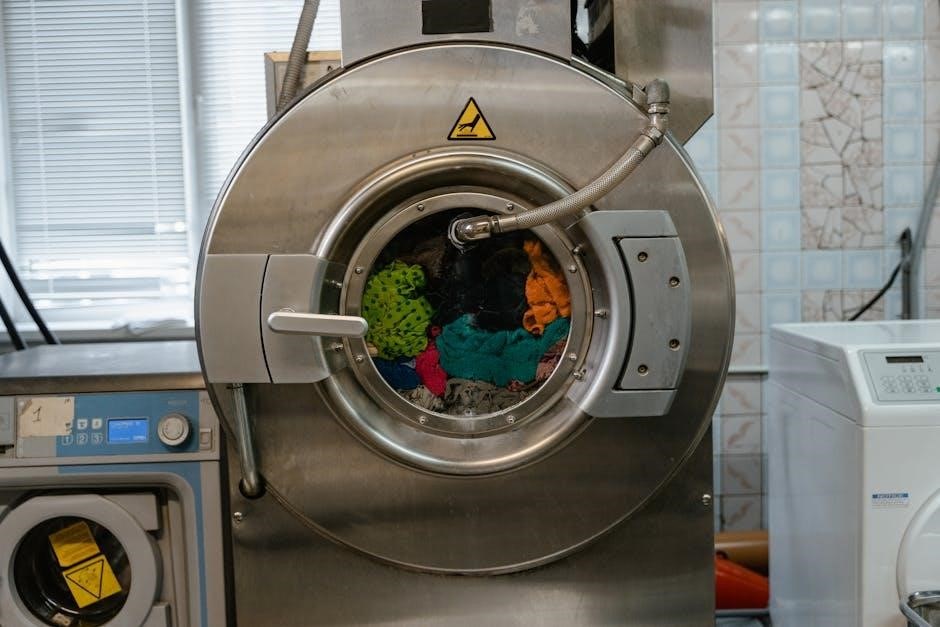
Maintenance Tips to Prevent Errors
Regularly clean your Kenmore washer, check hoses for leaks, and ensure proper connections. Follow usage guidelines to prevent errors and extend your appliance’s lifespan.
Regular Cleaning of the Washer
Regular cleaning is essential to maintain your Kenmore top-load washer’s performance and prevent error codes. Run a cleaning cycle monthly with a washer cleaner or vinegar to remove detergent residue and odors. Check and clean the gasket and drain pump filter regularly to ensure proper water flow and drainage. A clean washer reduces the risk of clogs and malfunctions, which can trigger error codes. Additionally, leaving the lid open after use allows the interior to dry, preventing mold and mildew buildup. By incorporating these simple maintenance steps, you can extend the life of your washer and avoid costly repairs.
Inspecting Hose Connections
Inspecting the hose connections on your Kenmore top-load washer is crucial to prevent water supply issues and leaks. Check the inlet and drain hoses for tightness and ensure they are securely attached to both the washer and the water supply sources. Look for signs of wear, such as cracks, kinks, or fraying, which can lead to poor water flow or leakage. Replace damaged hoses immediately to avoid triggering error codes like E1 (water supply issue) or E2 (drain pump problem). Regularly inspecting these connections can help maintain optimal performance and prevent costly repairs. Schedule hose inspections during routine maintenance or after moving the washer to ensure everything is in good working condition.
Following Proper Usage Guidelines
Adhering to proper usage guidelines is essential to ensure your Kenmore top-load washer operates efficiently and avoids common error codes. Always follow the manufacturer’s recommendations for load size, detergent type, and cycle selection. Overloading the washer can lead to imbalance issues, while using excessive detergent may cause excessive suds, triggering errors like E2 or E3. Regularly check the user manual for specific instructions tailored to your model, as guidelines may vary. Proper usage not only prevents errors but also extends the lifespan of your appliance. By maintaining balanced loads and ensuring the lid is closed securely, you can minimize the risk of mid-cycle interruptions and error code displays. Refer to the manual for detailed guidance on optimal usage practices.
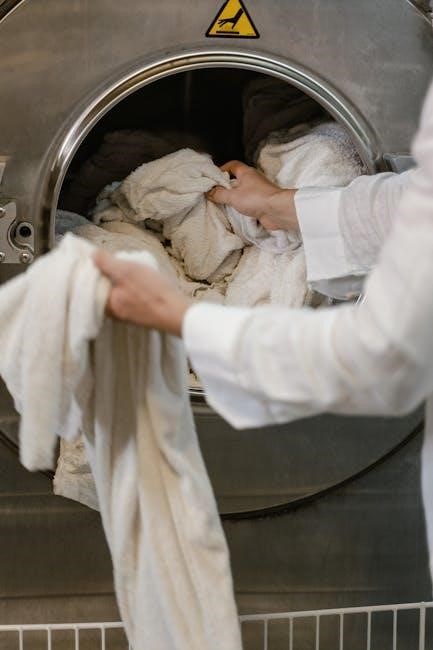
Advanced Troubleshooting Techniques
Advanced troubleshooting involves using diagnostic modes, testing sensors, and inspecting internal components to identify complex issues. This approach ensures precise error identification and effective resolution for your Kenmore washer.
Using Diagnostic Modes
Diagnostic modes are advanced tools designed to help identify and troubleshoot issues in your Kenmore top-load washer. By activating these modes, you can access detailed error codes, test components, and monitor sensor performance. To enter diagnostic mode, press and hold specific buttons (usually combinations like “Spin” and “Soil Level”) for a few seconds. Once activated, the washer will display stored error codes and allow manual testing of functions like water inlet, drain pump, and motor operation. This feature is invaluable for pinpointing faults without guessing. Always refer to your Kenmore washer’s official PDF guide for model-specific instructions, as diagnostic mode activation varies slightly between series. Regular use of diagnostic modes can help prevent minor issues from becoming major repairs.
Testing the Water Pressure Sensor
Testing the water pressure sensor is crucial for diagnosing errors like E1 or E3 in Kenmore top-load washers. The sensor monitors water flow and pressure, ensuring proper machine operation. To test it, start by disconnecting the washer from power. Locate the sensor, usually near the water inlet valve. Use a multimeter to measure resistance across the sensor terminals. Refer to your Kenmore PDF manual for specific resistance values. If readings are inconsistent, the sensor may be faulty. Additionally, check for blockages or kinks in the water supply hoses, as these can cause inaccurate sensor readings. Clean or replace hoses as needed. If issues persist after testing, consider replacing the sensor to restore proper water flow and pressure detection. Always follow safety guidelines when working with electrical components.
Inspecting the Hall Sensor and Motor
Inspecting the Hall sensor and motor is essential for resolving errors related to the washer’s rotational functions. The Hall sensor monitors the motor’s position and speed, ensuring synchronized operation. If faulty, it may trigger specific error codes. To inspect, disconnect power and access the motor area. Check the Hall sensor’s connections for damage or corrosion. Use a multimeter to test resistance across the sensor terminals. Compare readings with specifications from your Kenmore PDF manual. Additionally, inspect the motor for blockages or wear. Ensure the rotor and stator are clean and free from debris. If the sensor or motor is damaged, replacement may be necessary. Regular inspection helps prevent errors and ensures optimal performance. Always refer to your manual for model-specific guidance during this process.
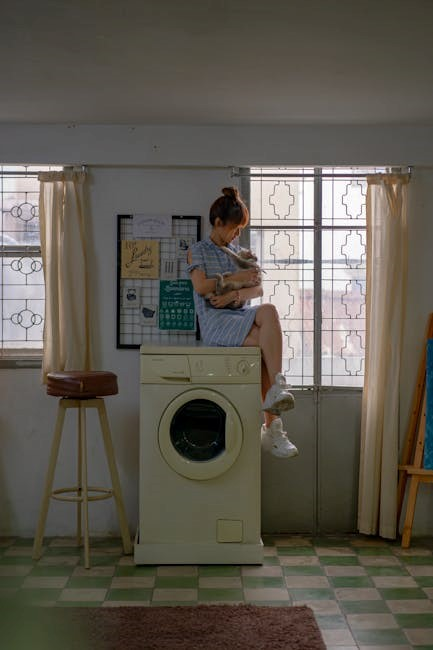
PDF Resources for Kenmore Washer Error Codes
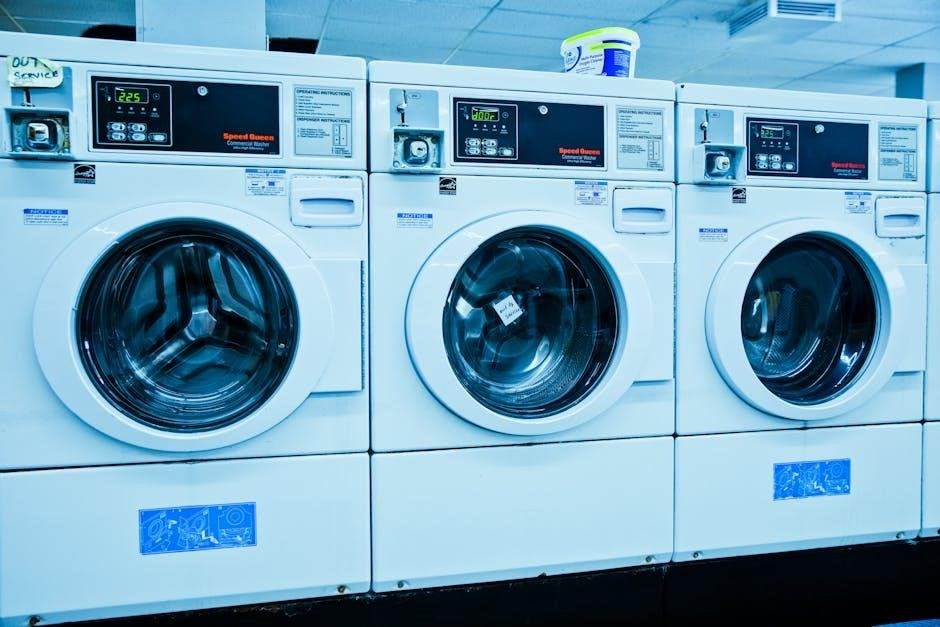
Access official Kenmore washer error code guides and third-party manuals for comprehensive troubleshooting. Download PDF resources to diagnose and repair issues efficiently.
Downloading the Official Kenmore Error Code Guide

The official Kenmore error code guide provides detailed explanations of error codes specific to top-load washers. It includes troubleshooting steps and repair guidance, helping you identify issues quickly. Available on Kenmore’s official website, this PDF resource is essential for diagnosing problems accurately. Ensure you reference the correct model number for precise information. The guide also offers maintenance tips to prevent future errors. For advanced troubleshooting, it includes diagnostic modes and sensor testing procedures. Downloading this guide ensures you have all the necessary tools to resolve issues efficiently. Additionally, third-party repair manuals are available for complementary insights and step-by-step repair instructions. Keep your Kenmore washer running smoothly by leveraging these resources.
Third-Party Repair Manuals and Guides
Third-party repair manuals and guides provide additional insights and solutions for diagnosing Kenmore top-load washer error codes. These resources often include detailed repair instructions, parts lists, and troubleshooting tips. They are particularly useful for DIY enthusiasts or technicians seeking alternative perspectives. Available online, these manuals can be downloaded in PDF format, offering comprehensive coverage of error codes and their fixes. Many third-party guides also include step-by-step repair procedures for common issues, such as faulty sensors or drain pump problems. While the official Kenmore guide is essential, third-party manuals can serve as a valuable supplement for advanced troubleshooting. Websites and forums dedicated to appliance repair frequently offer these resources, ensuring you have access to a wide range of diagnostic and repair strategies.